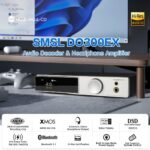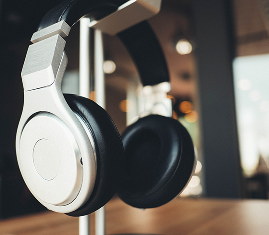Have you ever wondered why some headphones sound better than others? Well, one key factor contributing to the quality of headphones is their frequency response. But what exactly is the frequency response, and why is it so important? In this article, we’ll dive deep into headphone quality and explore the significance of frequency response. So, if you’re curious about how this affects your listening experience, keep reading!
If you’ve ever shopped for headphones, you may have encountered the term “frequency response” in product descriptions. But what does it mean? In simple terms, frequency response refers to the range of frequencies that headphones can reproduce accurately. It indicates how well headphones can produce both low and high-frequency sounds. A broader frequency response means the headphones can reproduce a more comprehensive range of frequencies, resulting in a more detailed and balanced sound. This article will discuss why a good frequency response is crucial for headphone quality and how it affects your listening experience. So, stay tuned to learn more about the significance of frequency response in headphone quality! Frequency response is a crucial aspect to consider when evaluating the quality of headphones. It refers to how well a pair of headphones can reproduce sound across the audible frequency range. In simpler terms, it measures how accurately the headphones can reproduce different frequencies, from the lowest bass notes to the highest treble tones.
Why is frequency response important for headphone quality? The human ear is most sensitive to frequencies between 20 Hz and 20,000 Hz. Hence, headphones with a broader frequency response can reproduce a greater range of frequencies, resulting in a more immersive and enjoyable listening experience. On the other hand, headphones with poor frequency response may not accurately reproduce specific frequencies, leading to a distorted or unbalanced sound.
Various factors can affect the frequency response of headphones
Transducer Type
The transducer is the component responsible for converting electrical signals into sound waves. There are two main types of transducers used in headphones: dynamic drivers and balanced armature drivers.
Dynamic drivers are the most common type, known for their ability to produce a wide frequency range. They can reproduce deep bass notes and high treble tones with relative accuracy. On the other hand, balanced armature drivers are smaller and more efficient, but they may not cover the entire frequency range as effectively as dynamic drivers.
Enclosure Design
The design and construction of the headphone enclosure can also affect its frequency response. Open-back headphones, for example, have perforated ear cups that allow sound to escape through the back. This design usually results in a wider soundstage and a more natural sound, but it may sacrifice some bass response.
On the other hand, closed-back headphones have sealed ear cups that isolate the listener from external noise and prevent sound leakage. This design often produces a more robust bass response but may have a narrower soundstage.
Crossover Components
For headphones with multiple drivers, such as those with separate drivers for bass, midrange, and treble frequencies, the crossover components play a crucial role in achieving a balanced frequency response. The crossover is responsible for dividing the audio signal into different frequency bands and directing them to the appropriate driver.
A well-designed crossover can ensure a smooth transition between frequency ranges and prevent overlapping or phase cancellation issues. On the other hand, a poorly designed crossover may result in frequency imbalances and affect the overall sound quality.
The role of frequency response in sound accuracy is significant. A balanced frequency response is often considered ideal, as the headphones can reproduce all frequencies with equal precision. This ensures no particular frequency dominates the sound, resulting in a more natural and true-to-life listening experience.
However, it’s important to note that not all headphones aim for a perfectly flat or balanced frequency response. Some headphones have a deliberately colored reply, meaning specific frequencies are emphasized or de-emphasized for various reasons. This can be to cater to particular music genres or personal preferences.
When evaluating frequency response, there are a few factors to consider:
Frequency Range
The frequency range of headphones refers to the lowest and highest frequencies they can reproduce. A wider frequency range generally indicates a more versatile pair of headphones that can handle a broader range of music genres and audio content.
Frequency Graphs
To visualize and understand the frequency response of headphones, manufacturers often provide frequency response graphs. These graphs show how the headphones measure different frequencies, usually decibels (dB). By looking at these graphs, you can see how the headphones may sound and whether there are any significant deviations or imbalances across the frequency spectrum.
Harmonic Distortion
Even with a flat or balanced frequency response, headphones can still suffer from harmonic distortion. This occurs when the sound produced by the headphones includes unwanted harmonic frequencies that were not present in the original audio signal. Harmonic distortion can result in a muddier sound and a loss of detail and clarity.
The implications of frequency response on sound quality are substantial. Headphones with an accurate frequency response can reproduce more detailed and clear sound, allowing you to pick up nuances in the music you might otherwise miss.
On the other hand, frequency imbalances can lead to specific frequencies overpowering others, resulting in a less enjoyable listening experience. For example, if the bass frequencies are significantly boosted, the vocals or other instruments may drown out, leading to a muffled or unbalanced sound.
The bass response of headphones is often a critical consideration for many listeners. A headphone with a solid bass response can enhance the impact and enjoyment of bass-heavy music genres, such as electronic dance music or hip-hop. However, it’s essential to balance to avoid overpowering other frequencies and sacrificing overall sound quality.
Understanding frequency response specifications can help you make informed decisions when purchasing headphones. Here are a few key specifications to pay attention to:
Frequency Response Range
The frequency response range of a pair of headphones indicates the lowest and highest frequencies it can reproduce accurately. For example, if a headphone has a frequency response range of 20 Hz to 20,000 Hz, it can faithfully reproduce all audible frequencies within this range.
Tolerance or Deviation
Headphones rarely have a perfectly flat frequency response across the entire audible spectrum. Tolerance or deviation specifies how much the headphone’s frequency response deviates from neutrality. Smaller tolerances indicate a more balanced sound, while larger tolerances may result in specific frequencies being exaggerated or dulled.
Impedance Variation
Impedance measures how much resistance headphones present to the audio source. Impedance variation describes how the headphone’s impedance changes across different frequencies. Significant variations in impedance can affect the overall sound quality and may result in distortion or imbalances in specific frequency ranges.
The relationship between frequency response and EQ (equalization) is essential. EQ adjustments can be based on the headphone’s frequency response to enhance or correct its sound signature.
For example, if your headphones’ bass frequencies are lacking, you can use EQ to boost those frequencies and achieve a more satisfying bass response. Conversely, if you feel the treble frequencies are too harsh, you can reduce them using EQ to achieve a smoother sound.
It’s worth noting that while EQ adjustments can help improve the sound quality, they should not be seen as a fix for headphones with poor frequency response. EQ adjustments can only do so much and cannot wholly compensate for significant frequency imbalances or limitations in the headphone’s design.
The preference for frequency response can differ depending on the musical genre. Specific genres, such as electronic dance music or hip-hop, often benefit from headphones with more robust bass response. On the other hand, genres like classical or jazz may require headphones with a more balanced and neutral frequency response to reproduce the intricate details and nuances of the music accurately.
When choosing headphones for specific genres, it’s essential to consider the frequency response and sound signature that best complements the music. Many manufacturers provide recommendations for different music genres based on the frequency response of their headphones.
For audiophiles and music professionals, the significance of frequency response becomes even more critical. They often look for headphones with a neutral sound signature that reproduces the audio as accurately and faithfully as possible. This allows them to make precise audio judgments and ensure that their mixes or recordings translate well to other audio systems.
Some headphones offer customizable frequency response through removable filters or interchangeable ear pads. This feature allows users to fine-tune the sound according to their preferences or specific music genres. It provides a level of versatility that can cater to a wide range of listening preferences.
For music professionals, studio monitoring headphones with a flat and accurate frequency response are essential for critical listening and proper audio production. These headphones ensure the audio is reproduced faithfully without distortion or imbalance, allowing professionals to judge the sound they are working with precisely.
In conclusion, the significance of frequency response in headphone quality cannot be overstated. It directly impacts the sound accuracy, detail, and overall listening experience. Understanding the various factors that affect frequency response, evaluating specifications, and considering genre preferences can help you choose headphones that best suit your needs and preferences. Whether you are a casual listener or a music professional, paying attention to frequency response ensures you get the most out of your headphones and enjoy music intended to be heard.










